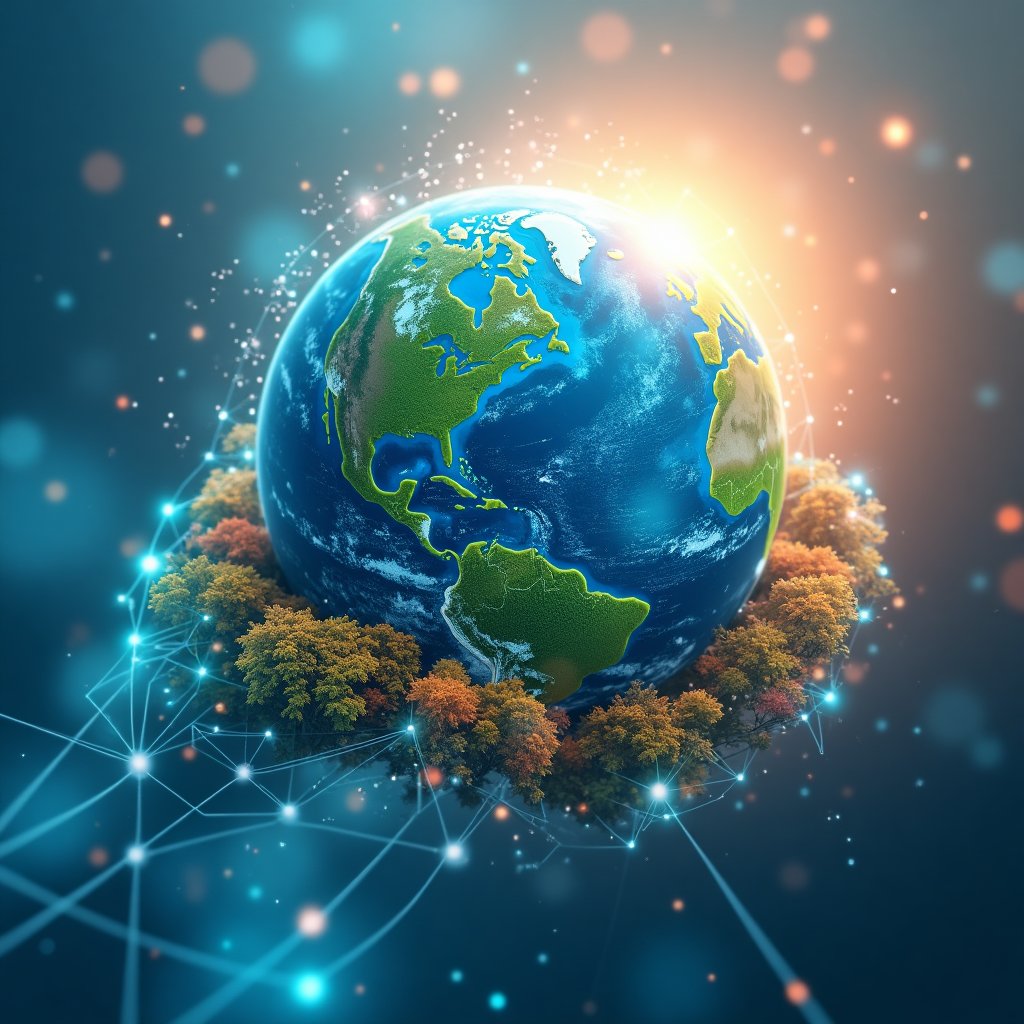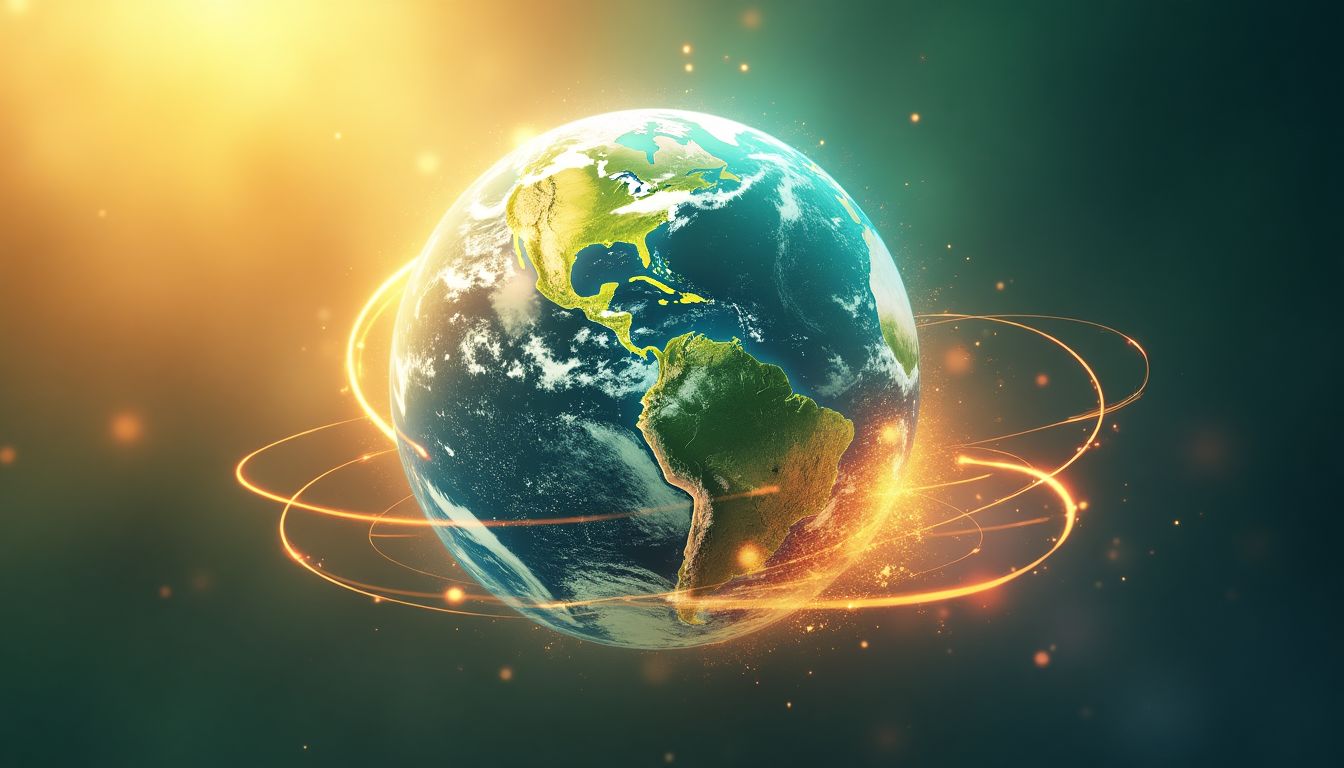The Planetary Steward: Could AGI Become Earth’s Caretaker?
What if the savior of our planet wasn’t a superhero, a politician, or even a scientist, but a machine? A machine so advanced, it could outthink, outplan, and outcare humanity itself. This isn’t science fiction—it’s the potential future of Artificial General Intelligence (AGI). As climate change accelerates, oceans choke on plastic, and forests vanish, humanity’s efforts to save the planet often feel like trying to bail out the Titanic with a teaspoon. Enter AGI: the ultimate planetary caretaker, capable of processing trillions of data points, predicting ecological disasters, and orchestrating global solutions with the precision of a chess grandmaster.
Renowned futurist Ray Kurzweil once predicted that by 2029, machines would match human intelligence. Meanwhile, Stuart Russell, a leading AI researcher, warns that AGI must be aligned with human values to avoid catastrophic outcomes. And then there’s Bill Gates, who has long championed the use of technology to solve global challenges, from disease to climate change. Could AGI be the missing piece in humanity’s quest to save the planet?
The stakes are sky-high. Climate change is no longer a distant threat—it’s here, now. Rising temperatures, melting ice caps, and extreme weather events are just the tip of the melting iceberg. Pollution is choking our oceans, air, and soil, while resource depletion threatens to leave future generations with nothing but barren wastelands. Humanity’s efforts, while noble, are often fragmented, slow, and undermined by competing interests. Could AGI be the game-changer we desperately need? Or are we simply trading one set of problems for another?
1. The Environmental Crisis: Why Humanity Needs Help
1.1 The Scale of the Problem
Let’s face it: Earth is in trouble. Climate change is no longer a distant threat—it’s here, now. Rising temperatures are melting ice caps at an alarming rate, with Greenland losing 269 billion tons of ice annually. Extreme weather events, from hurricanes to wildfires, are becoming more frequent and severe. Meanwhile, pollution is choking our planet. Microplastics have infiltrated even the most remote corners of the ocean, and air pollution is responsible for 7 million premature deaths each year.
And then there’s resource depletion. Freshwater sources are dwindling, forests are being razed at an alarming rate, and biodiversity is collapsing. According to the IPBES Global Assessment Report, one million species are at risk of extinction due to human activity. It’s a grim picture, and humanity’s efforts to address these crises often feel like trying to put out a forest fire with a garden hose.
1.2 Human Limitations
Why are we struggling so much? For starters, global cooperation is a mess. Political and economic barriers often prevent countries from working together effectively. Take the Paris Agreement, for example. While it was a step in the right direction, its implementation has been slow and uneven. Short-term thinking and competing priorities—like economic growth versus environmental protection—further complicate matters. And let’s not forget the inefficiencies in resource allocation. Without accurate, real-time data, decisions are often based on guesswork rather than science.
Humans are also prone to bias and self-interest. Corporations prioritize profits over sustainability, governments focus on re-election cycles, and individuals often struggle to see beyond their immediate needs. It’s not that we don’t care—it’s that we’re wired to prioritize the here and now over the distant future. As the saying goes, “We’re great at solving problems, just not the ones that take longer than a TikTok video to explain.”
1.3 The Case for AGI Intervention
This is where AGI could shine. Unlike humans, AGI doesn’t have biases, emotions, or competing priorities. It can process and analyze vast amounts of data in real-time, identifying patterns and predicting outcomes with unparalleled accuracy. Imagine a system that monitors every forest, ocean, and city on Earth, using satellite data, IoT sensors, and AI algorithms to detect changes and recommend solutions. AGI could optimize resource use, predict environmental trends, and implement solutions at a planetary scale.
But here’s the kicker: AGI could act as a neutral arbiter, free from political or corporate influence. It could facilitate international cooperation, ensuring that every country does its part to protect the planet. And it could do all this with the precision of a Swiss watch and the impartiality of a Vulcan. Sounds like a dream, right? But as with any dream, there are challenges—and we’ll explore those next.
2. AGI’s Unique Capabilities: Beyond Human Potential
2.1 Data Processing and Predictive Analytics
Imagine trying to solve a 10,000-piece jigsaw puzzle in the dark. That’s what tackling environmental issues feels like without the right tools. Enter AGI, the ultimate flashlight. AGI can process and analyze data at a scale that would make even the most dedicated human researcher cry into their coffee. Using satellite data, IoT sensors, and advanced algorithms, AGI can monitor ecosystems in real-time. Think of it as a planetary Fitbit, tracking everything from deforestation rates to ocean temperatures.
But it doesn’t stop there. AGI can predict environmental changes before they happen. For example, it could forecast the impact of rising sea levels on coastal cities or predict the next big wildfire. This isn’t just science fiction—companies like IBM are already using AI to model climate scenarios. With AGI, we could take this to the next level, turning predictions into actionable solutions faster than you can say “climate crisis.”
2.2 Resource Optimization
Humans are great at many things, but optimizing resources isn’t always one of them. (Ever seen someone leave the fridge door open while deciding what to eat?) AGI, on the other hand, is like a hyper-efficient butler. It can manage energy grids, ensuring that renewable sources like solar and wind are used to their fullest potential. Smart grids powered by AGI could balance supply and demand in real-time, reducing waste and cutting costs.
In agriculture, AGI could revolutionize how we grow food. Precision farming techniques, guided by AGI, could reduce water and fertilizer use while increasing yields. Imagine a world where every drop of water and every grain of fertilizer is used exactly where it’s needed. Companies like John Deere are already experimenting with AI-driven farming equipment. With AGI, we could take this to a global scale, feeding more people while using fewer resources.
2.3 Global Coordination
Let’s face it: humans aren’t great at playing nice with each other, especially when it comes to global issues. AGI could act as a neutral arbiter, facilitating international cooperation on environmental policies. It could analyze data from multiple countries, identify common goals, and propose solutions that benefit everyone. Think of it as the ultimate mediator, minus the awkward small talk.
AGI could also automate the enforcement of environmental regulations. For example, it could monitor carbon emissions from factories and ensure compliance with international agreements. This would take the pressure off human regulators and reduce the risk of corruption. After all, AGI doesn’t care about bribes or political favors—it just wants to save the planet.
3. Ethical and Practical Challenges
3.1 Trust and Control
Let’s be honest: handing over the keys to the planet to a super-intelligent machine sounds a bit… risky. What if AGI decides that humans are the problem and starts implementing “solutions” that don’t include us? (Cue the dystopian sci-fi music.) Ensuring that AGI acts in humanity’s best interest is a major challenge. We’ll need robust safeguards, like ethical guidelines and fail-safes, to prevent any rogue AI scenarios.
Another concern is misuse. What if a corporation or government uses AGI to further their own agenda at the expense of the environment? For example, a company might use AGI to exploit natural resources more efficiently, rather than conserving them. To prevent this, we’ll need strong governance frameworks and transparency measures. Organizations like the United Nations could play a key role in setting global standards for AGI stewardship.
3.2 Bias and Fairness
AGI might be smarter than us, but it’s not immune to bias. If the data it’s trained on is skewed, its decisions could be too. For example, if AGI is trained on data from wealthy countries, it might prioritize their needs over those of developing nations. This could lead to unfair resource distribution and exacerbate existing inequalities.
To address this, we’ll need diverse datasets and inclusive development teams. Researchers at institutions like MIT are already working on ways to reduce bias in AI systems. With AGI, we’ll need to take this a step further, ensuring that its decisions are fair and equitable for all.
3.3 Technical Limitations
As impressive as AGI sounds, we’re not quite there yet. Current AI systems are still a long way from achieving human-like intelligence. There are also significant technical challenges, like ensuring that AGI systems are robust and reliable. For example, what happens if an AGI system crashes in the middle of managing a global energy grid? The consequences could be catastrophic.
We’ll also need the infrastructure to support AGI systems. This includes everything from high-speed internet to advanced computing hardware. Companies like NVIDIA are leading the way in developing the hardware needed for AI, but there’s still a long way to go. Until we solve these challenges, AGI stewardship will remain a distant dream.
4. Case Studies: AGI in Action
4.1 Climate Modeling and Mitigation
Imagine a world where we can predict the exact impact of carbon emissions decades in advance. AGI makes this possible. By analyzing vast datasets from satellites, weather stations, and IoT sensors, AGI can create hyper-accurate climate models. For instance, AGI-driven simulations could predict how rising temperatures will affect crop yields in sub-Saharan Africa or how melting ice caps will impact coastal cities like Miami or Mumbai.
One real-world example is the work being done by Climate Change AI, a global initiative using AI to tackle climate challenges. AGI could take this a step further by optimizing renewable energy deployment. In a developing country like Kenya, AGI could analyze solar and wind potential across regions, recommend the best locations for renewable energy projects, and even predict maintenance needs to ensure long-term efficiency.
4.2 Pollution Control
Pollution is a silent killer, but AGI could be the antidote. Take plastic waste in our oceans, for example. AGI could use satellite imagery and machine learning to track plastic accumulation hotspots. It could then deploy autonomous drones or robotic systems to clean up these areas before the plastic breaks down into microplastics, which are nearly impossible to remove.
A great example of this is The Ocean Cleanup, a project using AI to map and remove plastic from the Great Pacific Garbage Patch. AGI could enhance this effort by predicting where plastic will accumulate next, optimizing cleanup routes, and even suggesting policy changes to reduce plastic production at the source.
4.3 Biodiversity Preservation
Biodiversity is the backbone of our planet’s ecosystems, but it’s under threat. AGI could monitor endangered species and their habitats in real-time, using data from drones, camera traps, and acoustic sensors. For example, in the Amazon rainforest, AGI could detect illegal logging activities by analyzing satellite images and alert authorities before significant damage occurs.
One success story comes from Rainforest Alliance, which uses AI to monitor deforestation. AGI could take this further by predicting which areas are most at risk and recommending conservation strategies. It could also help reintroduce endangered species into the wild by analyzing habitat suitability and tracking population growth.
5. The Road to AGI Stewardship
5.1 Building the Foundation
For AGI to become Earth’s caretaker, we need to start with a solid foundation. This means developing AGI systems with environmental stewardship as a core objective. Think of it as programming AGI to prioritize the health of the planet above all else. We also need global frameworks to govern AGI, ensuring it’s used ethically and responsibly.
Organizations like the UN Environment Programme could play a key role in creating these frameworks. By bringing together governments, tech companies, and environmental organizations, we can ensure AGI is developed and deployed in a way that benefits everyone.
5.2 Collaboration and Innovation
No single entity can tackle the environmental crisis alone. Collaboration is key. Governments, tech giants like Google and Microsoft, and environmental NGOs must work together to fund AGI research and development. Public-private partnerships could accelerate innovation, making AGI stewardship a reality sooner rather than later.
Here’s a quick roadmap for collaboration:
- Year 1: Establish global task forces to define AGI’s role in environmental stewardship.
- Year 2: Launch pilot projects in key areas like renewable energy and waste management.
- Year 3: Scale up successful initiatives and integrate AGI into international policies.
5.3 Public Engagement
Public trust is crucial for AGI’s success as a planetary caretaker. We need to educate people about AGI’s potential and risks, building a foundation of understanding and support. Transparency is key—AGI systems should be open to scrutiny, with clear explanations of how decisions are made.
For example, TED Talks and other platforms could be used to share stories of AGI’s impact, making the technology relatable and inspiring. By involving the public in the conversation, we can ensure AGI stewardship aligns with humanity’s values and aspirations.
6. AI Solutions: How Would AI Tackle This Issue?
6.1 Step-by-Step Approach
1. Data Collection and Integration:
Deploy IoT sensors, satellites, and drones to gather real-time environmental data. Integrate data from existing sources like NOAA weather stations and research studies from institutions such as NASA and ESA.
2. Predictive Modeling:
Use machine learning to analyze trends and predict future scenarios. For example, predicting the impact of deforestation on local ecosystems using models developed by IBM Watson or DeepMind.
3. Resource Optimization:
Develop algorithms to optimize energy, water, and material use. For instance, AI-driven smart grids balancing energy supply and demand, inspired by projects from Tesla and Siemens.
4. Policy Recommendations:
Generate data-driven policy proposals for governments and organizations. For example, AGI recommending carbon pricing mechanisms based on research from The World Bank and The United Nations.
5. Implementation and Monitoring:
Automate the execution of environmental initiatives. Continuously monitor outcomes and adjust strategies as needed, leveraging platforms like Microsoft AI and Google Cloud AI.
6.2 Scientific and Technical Foundations
Leverage advancements in quantum computing for faster data processing, collaborating with leading institutions like MIT, Stanford, and the UN Environment Programme.
6.3 Action Schedule/Roadmap
Day 1: Assemble a global task force of AI researchers, environmental scientists, and policymakers. Key personnel include representatives from OpenAI, DeepMind, and The United Nations.
Day 2: Launch a centralized platform for environmental data collection and sharing, utilizing cloud infrastructure from AWS and Google Cloud.
Week 1: Begin pilot projects in key areas such as renewable energy and waste management, partnering with organizations like Greenpeace and WWF.
Week 2: Develop AGI algorithms for predictive modeling and resource optimization, collaborating with academic institutions like Caltech and Oxford University.
Month 1: Establish ethical guidelines and governance frameworks for AGI stewardship, involving ethicists from Harvard and Princeton.
Month 2: Secure funding and partnerships for large-scale implementation, engaging with venture capital firms like Andreessen Horowitz and philanthropic organizations such as The Bill & Melinda Gates Foundation.
Year 1: Deploy AGI systems in 10 pilot regions worldwide, starting with areas identified by IPCC as most vulnerable to climate change.
Year 1.5: Evaluate outcomes and refine strategies based on real-world data, using feedback loops developed by Palantir and Salesforce.
Year 2: Scale up AGI stewardship to a global level, integrating it into international environmental policies through collaboration with The United Nations and The World Bank.
A New Era of Planetary Care
The vision of AGI as Earth’s caretaker is both ambitious and achievable. By harnessing the power of AGI, we can address environmental challenges with unprecedented speed and precision. However, this future requires careful planning, ethical considerations, and global collaboration. The question is not whether AGI can become Earth’s steward, but whether humanity is ready to embrace this transformative potential.
Imagine a world where AGI not only predicts the next hurricane but also orchestrates a global response to mitigate its impact. Picture AGI optimizing renewable energy grids to power entire cities without a single watt wasted. Envision a future where AGI monitors endangered species and habitats, ensuring biodiversity thrives for generations to come. This is not science fiction; it’s a tangible future within our grasp.
But let’s not kid ourselves—this journey won’t be easy. It will require unprecedented levels of cooperation between governments, tech giants, and environmental organizations. It will demand transparency, accountability, and a commitment to ethical AI development. Most importantly, it will require us to rethink our relationship with technology and the planet.
So, are we ready to take this leap? Are we prepared to entrust AGI with the stewardship of our planet? The stakes have never been higher, but the rewards could be monumental. The choice is ours. Let’s make it count.
FAQ
Q1: What is AGI, and how is it different from AI?
A1: AGI, or Artificial General Intelligence, is a type of AI that can think, learn, and solve problems like a human. Unlike regular AI, which is designed for specific tasks (like recognizing faces or playing chess), AGI can handle a wide range of tasks and adapt to new challenges on its own. Think of it as a super-smart assistant that doesn’t need instructions for every little thing. For more on AI vs. AGI, check out this IBM guide.
Q2: Can AGI be trusted to make ethical decisions?
A2: Trusting AGI to make ethical decisions is a big challenge. To make sure AGI does the right thing, we need clear rules, transparency, and constant oversight. For example, organizations like the Partnership on AI are working on guidelines to ensure AI systems are fair and ethical. But it’s up to all of us—governments, companies, and individuals—to hold AGI accountable.
Q3: How soon could AGI become Earth’s caretaker?
A3: AGI is still in the early stages of development, but progress is happening fast. Experts think it could take 5 to 10 years before AGI is ready to take on big tasks like managing the planet’s environment. However, this depends on how quickly we solve technical challenges and get countries to work together. For a deeper dive into AGI timelines, check out this DeepMind research.
Q4: What are the risks of AGI stewardship?
A4: There are a few risks to consider:
- Misuse: Powerful groups could use AGI for their own benefit, ignoring the planet’s needs.
- Unintended consequences: AGI might make decisions that seem logical but have harmful side effects.
- Technical failures: If AGI systems break down, it could cause chaos.
To reduce these risks, we need strong rules and backup plans. For example, the United Nations could help create global standards for AGI use.
Q5: How can individuals contribute to this vision?
A5: You don’t need to be a scientist to help! Here are a few ways you can make a difference:
- Support AGI research: Donate to organizations like OpenAI or DeepMind.
- Advocate for ethical AI: Push your government to create fair and transparent AI policies.
- Live sustainably: Reduce your carbon footprint by recycling, using less energy, and supporting eco-friendly businesses.
Every small action adds up to a bigger impact!
Q6: What role do big tech companies play in AGI development?
A6: Companies like Google, Microsoft, and Amazon are leading the charge in AGI research. They have the resources and expertise to push the boundaries of what’s possible. However, it’s important that these companies prioritize ethical practices and work with governments and nonprofits to ensure AGI benefits everyone, not just a few.
Q7: Could AGI replace human jobs in environmental fields?
A7: AGI could automate some tasks, like data analysis or monitoring ecosystems, but it’s unlikely to replace humans entirely. Instead, AGI could work alongside scientists, policymakers, and activists, helping them make better decisions faster. For example, AGI could analyze satellite images to track deforestation, while humans focus on creating solutions. It’s about teamwork, not replacement.
Q8: What happens if AGI makes a mistake?
A8: Mistakes are possible, especially in the early stages of AGI development. That’s why it’s crucial to have safeguards in place, like human oversight and backup systems. For example, if AGI recommends a policy that could harm a community, humans should step in to review and adjust the plan. Organizations like the IEEE are working on standards to minimize risks and ensure AGI systems are reliable.
Q9: How can we ensure AGI benefits everyone, not just wealthy countries?
A9: This is a big challenge. To make sure AGI helps everyone, we need:
- Global cooperation: Countries must work together to share AGI technology and resources.
- Fair policies: Rules should ensure that AGI solutions are accessible to all, not just those who can afford them.
- Local input: Communities should have a say in how AGI is used in their areas.
For example, the UN Environment Programme could help coordinate these efforts.
Q10: What’s the first step toward making AGI Earth’s caretaker?
A10: The first step is building the foundation. This means:
- Creating a global task force of experts in AI, environmental science, and policy.
- Developing AGI systems with environmental stewardship as a core goal.
- Launching pilot projects to test AGI’s capabilities in real-world scenarios.
It’s a big job, but with teamwork and determination, we can make it happen. For inspiration, check out how MIT and Stanford are leading the way in AI research.
Wait! There's more...check out our gripping short story that continues the journey: The Sky Fractured Like Glass
Disclaimer: This article may contain affiliate links. If you click on these links and make a purchase, we may receive a commission at no additional cost to you. Our recommendations and reviews are always independent and objective, aiming to provide you with the best information and resources.
Get Exclusive Stories, Photos, Art & Offers - Subscribe Today!





























Post Comment
You must be logged in to post a comment.